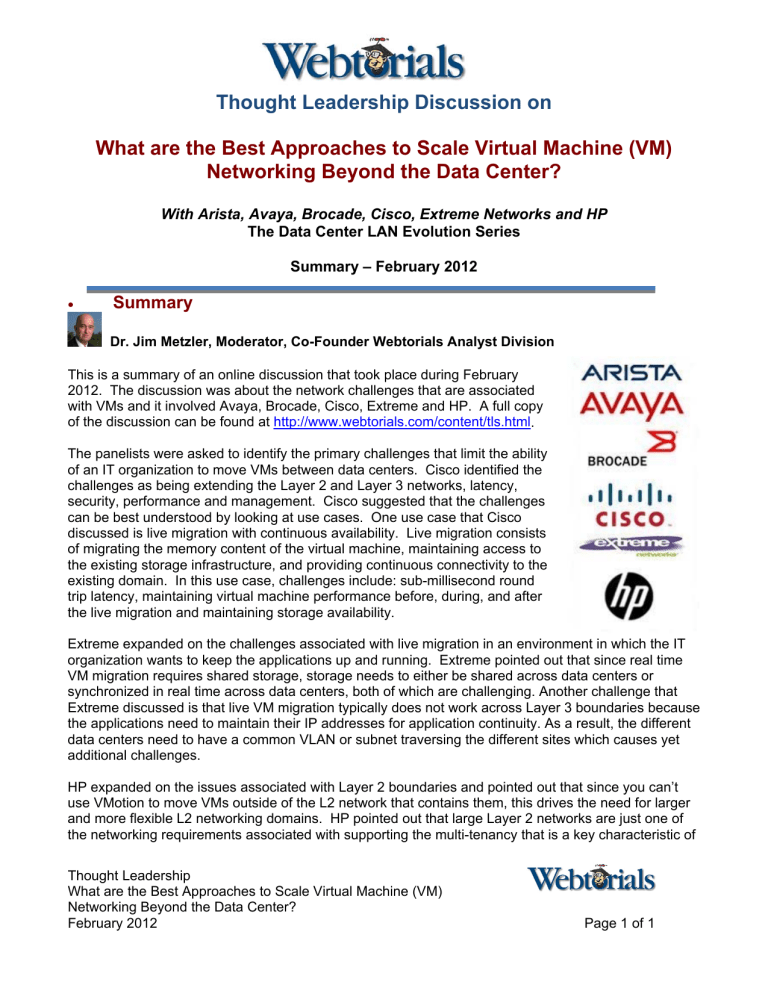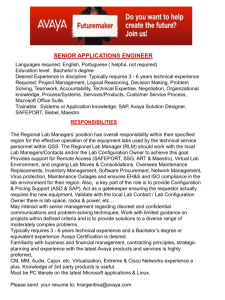Thought Leadership Discussion on Networking Beyond the Data Center?

Thought Leadership Discussion on
What are the Best Approaches to Scale Virtual Machine (VM)
Networking Beyond the Data Center?
With Arista, Avaya, Brocade, Cisco, Extreme Networks and HP
The Data Center LAN Evolution Series
Summary – February 2012
Summary
Dr. Jim Metzler, Moderator, Co-Founder Webtorials Analyst Division
This is a summary of an online discussion that took place during February
2012. The discussion was about the network challenges that are associated with VMs and it involved Avaya, Brocade, Cisco, Extreme and HP. A full copy of the discussion can be found at http://www.webtorials.com/content/tls.html
.
The panelists were asked to identify the primary challenges that limit the ability of an IT organization to move VMs between data centers. Cisco identified the challenges as being extending the Layer 2 and Layer 3 networks, latency, security, performance and management. Cisco suggested that the challenges can be best understood by looking at use cases. One use case that Cisco discussed is live migration with continuous availability. Live migration consists of migrating the memory content of the virtual machine, maintaining access to the existing storage infrastructure, and providing continuous connectivity to the existing domain. In this use case, challenges include: sub-millisecond round trip latency, maintaining virtual machine performance before, during, and after the live migration and maintaining storage availability.
Extreme expanded on the challenges associated with live migration in an environment in which the IT organization wants to keep the applications up and running. Extreme pointed out that since real time
VM migration requires shared storage, storage needs to either be shared across data centers or synchronized in real time across data centers, both of which are challenging. Another challenge that
Extreme discussed is that live VM migration typically does not work across Layer 3 boundaries because the applications need to maintain their IP addresses for application continuity. As a result, the different data centers need to have a common VLAN or subnet traversing the different sites which causes yet additional challenges.
HP expanded on the issues associated with Layer 2 boundaries and pointed out that since you can’t use VMotion to move VMs outside of the L2 network that contains them, this drives the need for larger and more flexible L2 networking domains. HP pointed out that large Layer 2 networks are just one of the networking requirements associated with supporting the multi-tenancy that is a key characteristic of
Thought Leadership
What are the Best Approaches to Scale Virtual Machine (VM)
Networking Beyond the Data Center?
February 2012 Page 1 of 1
cloud computing. Other requirements include the secure separation of traffic flows between tenants of a common network infrastructure and getting around the traditional limit of 4,096 VLAN tags. HP concluded by stating that in order to address these limitations, the industry is developing standards based encapsulation methods that provide Layer 2 network abstractions to virtual machines, independent of their location in the network.
Avaya focused on the management issues that are associated with supporting the movement of VMs.
Avaya stated that while stitching together various protocols or deploying an end-to-end fabric between multiple data centers may address virtual boundaries, there remains the issue of integration between the virtual environment and the network environment. Avaya discussed the importance of integrating
VMware’s vCenter and the switch vendor’s provisioning system in order to allow the migration process for a VM to seamlessly trigger the corresponding adaptation of the network. Avaya also pointed out the importance of VXLAN and stated that data center architects should choose an architecture that addresses the underlying complexity of VXLAN transport and also enables communication between both VXLAN and non-VXLAN environments.
Brocade stated that until recently that IT organizations typically either shut down a VM or put it into a
“quiet state” before moving it between data centers. Brocade added that there are emerging products and solutions that allow VMs to be moved between data centers “live” but that there are 3 key areas that IT organizations should consider when designing a network to support live migrations. One area is ensuring that applications residing on a VM will have adequate network resources, and that parameters such as VLAN profiles, QoS and security ACLs are available and applied throughout the network when a VM is moved. The second area is to ensure that the network provides high performance, high reliability, security and proper layer 2 extension capabilities. The third area is the orchestration of workflows, such as the dynamic routing of client traffic to the new VM location once the migration completes.
Thought Leadership
What are the Best Approaches to Scale Virtual Machine (VM)
Networking Beyond the Data Center?
February 2012 Page 2 of 2

